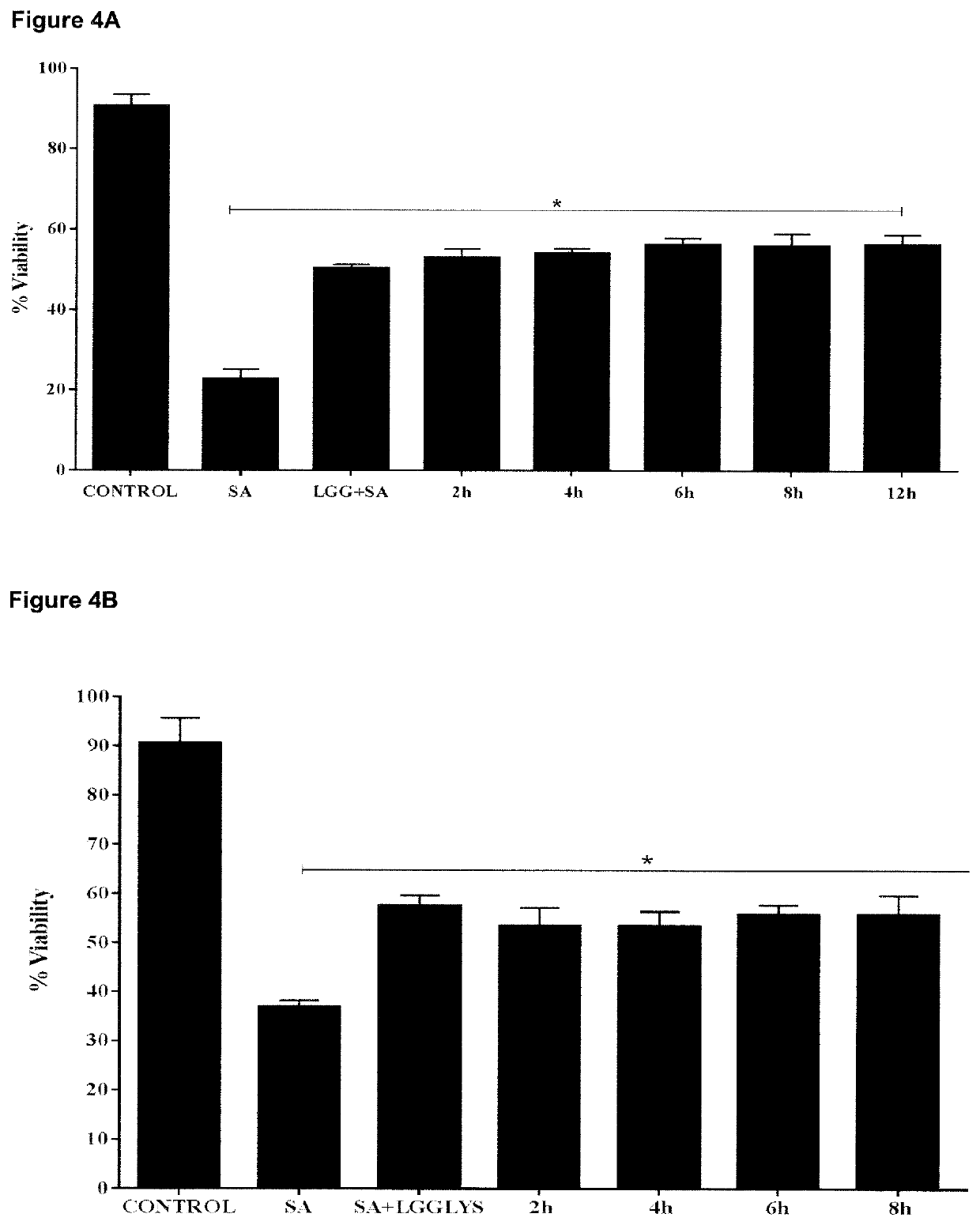Anti-bacterial lysate of probiotic bacteria
a technology of probiotic bacteria and lysate, which is applied in the direction of antibacterial agents, living procariotic cell medical ingredients, antibacterial agents, etc., can solve the problem that the culture fluid is only protective, and achieve the effects of reducing bacterial adhesion, enhancing keratinocyte survival, and inhibiting s adheren
- Summary
- Abstract
- Description
- Claims
- Application Information
AI Technical Summary
Benefits of technology
Problems solved by technology
Method used
Image
Examples
example 1
Materials and Methods
[0084]Mammalian Cell Culture
[0085]Normal human epidermal keratinocytes (NHEK) cultured in keratinocyte basal medium (Promocell, Heidelberg, Germany) containing a supplement mix (bovine pituitary extract 0.004 mg / ml, epidermal growth factor (recombinant human) 0.125 ng / ml, insulin (recombinant human) 5 μg / ml, hydrocortisone 0.33 μg / ml, epinephrine 0.39 μg / ml and transferrin, holo (human) 10 μg / ml) and 0.06 mM CaCl2 (Promocell, Heidelberg, Germany), were used as a model system. These were cultured routinely at 37° C. in a humid atmosphere of 5% CO2 in T-75 culture flasks as described previously (43).
[0086]Bacterial Cell Culture
[0087]Lactobacillus rhamnosus Goldin and Gorbach (L. rhamnosus GG) (ATCC 53103, ATCC, Middlesex, UK) was grown routinely in Wilkins-Chalgren Broth or Agar (Oxoid, Basingstoke, UK) at 37° C. in incubated in an anaerobic cabinet (atmosphere, 10:10:80, H2—CO2—N2). Staphylococcus aureus was grown aerobically at 37° C. in Nutrient Broth (Oxoid, B...
example 2
Results
[0100]L. rhamnosus GG Protects Keratinocytes from the Pathogenic Effects of S. aureus.
[0101]Initially, we investigated whether the viability of keratinocytes was affected by incubation with L. rhamnosus GG. However, following 24 h incubation, there was no difference in the viability of keratinocytes incubated with the probiotic bacteria vs the control of untreated keratinocytes (data not shown). Next, the ability of L. rhamnosus GG to protect keratinocytes from the effects of S. aureus was investigated. In agreement with our previous findings (43) 24 h exposure of keratinocytes to 106 CFU / ml S. aureus resulted in significant keratinocyte cell death. However, keratinocytes incubated simultaneously with pathogen and L. rhamnosus GG had a significantly higher percentage viability (57% P=0.01) than monolayers infected with pathogen alone (FIG. 1).
[0102]L. rhamnosus GG Lysates and Spent Culture Fluid Protect Keratinocytes from the Effects of S. aureus.
[0103]We investigated wheth...
PUM
 Login to View More
Login to View More Abstract
Description
Claims
Application Information
 Login to View More
Login to View More - R&D
- Intellectual Property
- Life Sciences
- Materials
- Tech Scout
- Unparalleled Data Quality
- Higher Quality Content
- 60% Fewer Hallucinations
Browse by: Latest US Patents, China's latest patents, Technical Efficacy Thesaurus, Application Domain, Technology Topic, Popular Technical Reports.
© 2025 PatSnap. All rights reserved.Legal|Privacy policy|Modern Slavery Act Transparency Statement|Sitemap|About US| Contact US: help@patsnap.com



